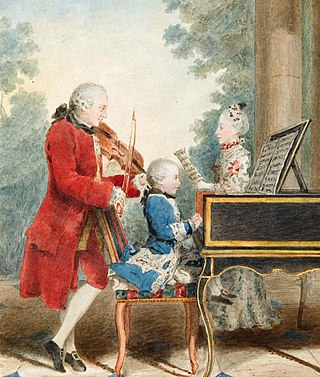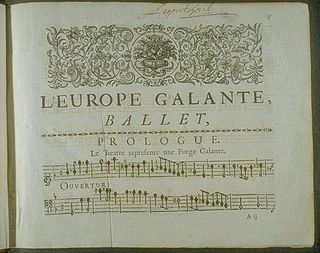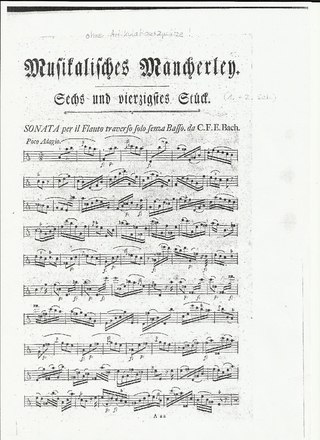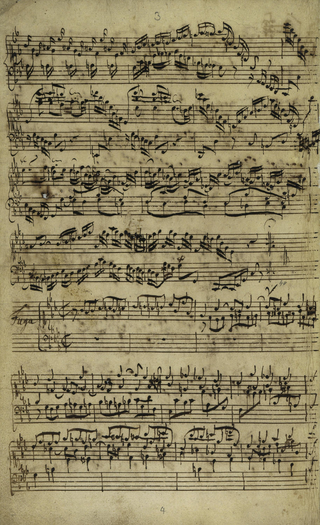Related Research Articles

The Classical period was an era of classical music between roughly 1750 and 1820.

Carl Philipp Emanuel Bach, also formerly spelled Karl Philipp Emmanuel Bach, and commonly abbreviated C. P. E. Bach, was a German Classical period composer and musician, the fifth child and second surviving son of Johann Sebastian Bach and Maria Barbara Bach.

Johann Joachim Quantz was a German composer, flutist and flute maker of the late Baroque period. Much of his professional career was spent in the court of Frederick the Great. Quantz composed hundreds of flute sonatas and concertos, and wrote On Playing the Flute, an influential treatise on flute performance. His works were known and appreciated by Bach, Haydn and Mozart.
The trio sonata is a genre, typically consisting of several movements, with two melody instruments and basso continuo. Originating in the early 17th century, the trio sonata was a favorite chamber ensemble combination in the Baroque era.

In music, galant refers to the style which was fashionable from the 1720s to the 1770s. This movement featured a return to simplicity and immediacy of appeal after the complexity of the late Baroque era. This meant simpler, more song-like melodies, decreased use of polyphony, short, periodic phrases, a reduced harmonic vocabulary emphasizing tonic and dominant, and a clear distinction between soloist and accompaniment. C. P. E. Bach and Daniel Gottlob Türk, who were among the most significant theorists of the late 18th century, contrasted the galant with the "learned" or "strict" styles. The German empfindsamer Stil, which seeks to express personal emotions and sensitivity, can be seen either as a closely related North-German dialect of the international galant style, or as contrasted with it, as between the music of Carl Philipp Emanuel Bach, a founder of both styles, and that of Johann Christian Bach, who carried the galant style further and was closer to classical.

Johann Wilhelm Hertel was a German composer, harpsichord and violin player.

Johann Kuhnau was a German polymath, known primarily as a composer today. He was also active as a novelist, translator, lawyer, and music theorist, and was able to combine these activities with his duties in his official post as Thomaskantor in Leipzig, which he occupied for 21 years. Much of his music, including operas, masses, and other large-scale vocal works, is lost. His reputation today rests on his Biblical Sonatas, a set of programmatic keyboard sonatas published in 1700, in which each sonata depicted in detail a particular story from the Bible. After his death, Kuhnau was succeeded as Thomaskantor by Johann Sebastian Bach.
The galant style was an 18th-century movement in music, visual arts and literature. In Germany a closely related style was called the empfindsamer Stil. Another close relative is rococo style. The galant style was drawn in opposition to the strictures of the Baroque style, emphasizing light elegance in place of the Baroque's dignified seriousness and high grandeur.
Johann Gottlieb Graun was a German Baroque/Classical era composer and violinist, born in Wahrenbrück. His brother Carl Heinrich was a singer and also a composer, and is the better known of the two.
Johann Paul von Westhoff was a German Baroque composer and violinist. One of the most important exponents of the Dresden violin school, he was among the highest ranked violinists of his day, and composed some of the earliest known music for solo violin. He worked as musician and composer as a member of Dresden's Hofkapelle (1674–1697) and at the Weimar court (1699–1705), and was also active as a teacher of contemporary languages.
Sentimentalism is a practice of being sentimental, and thus tending towards making emotions and feelings the basis of a person's actions and reactions, as opposed to reason.
Johann Gottlieb Janitsch was a German Baroque composer who wrote in the galant style, transitional between the Baroque and Classical periods.
The Sonata in E♭ major for flute and harpsichord, probably by J. S. Bach, is a sonata in 3 movements:

The Sonata in E major for flute and basso continuo is a sonata for transverse flute and figured bass composed by J. S. Bach in the 1740s. It was written as the result of a visit in 1741 to the court of Frederick the Great in Potsdam, where Bach's son Carl Philipp Emanuel had been appointed principal harpsichordist to the king the previous year. It was dedicated to Michael Gabriel Fredersdorf, the king's valet and private secretary, who, like the king, was an amateur flautist.

Baroque music refers to the period or dominant style of Western classical music composed from about 1600 to 1750. The Baroque style followed the Renaissance period, and was followed in turn by the Classical period after a short transition. The Baroque period is divided into three major phases: early, middle, and late. Overlapping in time, they are conventionally dated from 1580 to 1650, from 1630 to 1700, and from 1680 to 1750. Baroque music forms a major portion of the "classical music" canon, and is widely studied, performed, and listened to. The term "baroque" comes from the Portuguese word barroco, meaning "misshapen pearl". The works of George Frideric Handel, Antonio Vivaldi and Johann Sebastian Bach are considered the pinnacle of the Baroque period. Other key composers of the Baroque era include Claudio Monteverdi, Domenico Scarlatti, Alessandro Scarlatti, Alessandro Stradella, Tomaso Albinoni, Johann Pachelbel, Henry Purcell, Georg Philipp Telemann, Jean-Baptiste Lully, Jean-Philippe Rameau, Marc-Antoine Charpentier, Arcangelo Corelli, François Couperin, Johann Hermann Schein, Heinrich Schütz, Samuel Scheidt, Dieterich Buxtehude, and others.

The Canonic Variations on "Vom Himmel hoch da komm' ich her", BWV 769, are a set of five variations in canon for organ with two manuals and pedals by Johann Sebastian Bach on the Christmas hymn by Martin Luther of the same name. The variations were prepared as a showpiece for Bach's entry as fourteenth member of Mizler's Music Society in Leipzig in 1747. The original printed edition of 1747, in which only one line of the canon was marked in the first three variations, was published by Balthasar Schmid in Nuremberg. Another version BWV 769a appears in the later autograph manuscript P 271, which also contains the six trio sonatas for organ BWV 525–530 and the Great Eighteen Chorale Preludes BWV 651–668. In this later version Bach modified the order of the variations, moving the fifth variation into a central position, and wrote out all the parts in full, with some minor revisions to the score.
These [variations] are full of passionate vitality and poetical feeling. The heavenly hosts soar up and down, their lovely song sounding out over the cradle of the Infant Christ, while the multitude of the redeemed "join the sweet song with joyful hearts." But the experiences of a fruitful life of sixty years have interwoven themselves with the emotions which possessed him in earlier years ... The work has an element of solemn thankfulness, like the gaze of an old man who watches his grandchildren standing round their Christmas tree, and is reminded of his own childhood.
The brilliant scale passages not only represent the ascending and descending angels, but sound joyous peals from many belfries ringing in the Saviour's birth.

The six sonatas for violin and obbligato harpsichord BWV 1014–1019 by Johann Sebastian Bach are works in trio sonata form, with the two upper parts in the harpsichord and violin over a bass line supplied by the harpsichord and an optional viola da gamba. Unlike baroque sonatas for solo instrument and continuo, where the realisation of the figured bass was left to the discretion of the performer, the keyboard part in the sonatas was almost entirely specified by Bach. They were probably mostly composed during Bach's final years in Cöthen between 1720 and 1723, before he moved to Leipzig. The extant sources for the collection span the whole of Bach's period in Leipzig, during which time he continued to make changes to the score.

The organ sonatas, BWV 525–530 by Johann Sebastian Bach are a collection of six sonatas in trio sonata form. Each of the sonatas has three movements, with three independent parts in the two manuals and obbligato pedal. The collection was put together in Leipzig in the late 1720s and contained reworkings of prior compositions by Bach from earlier cantatas, organ works and chamber music as well as some newly composed movements. The sixth sonata, BWV 530, is the only one for which all three movements were specially composed for the collection. When played on an organ, the second manual part is often played an octave lower on the keyboard with appropriate registration. Commentators have suggested that the collection might partly have been intended for private study to perfect organ technique, some pointing out that its compass allows it to be played on a pedal clavichord. The collection of sonatas is generally regarded as one of Bach's masterpieces for organ. The sonatas are also considered to be amongst his most difficult compositions for the instrument.

The Sonata for Solo Flute in A minor, Wq.132, H 562, is a sonata for flute, without Basso Continuo or accompanying instruments, composed by Carl Philipp Emanuel Bach. The sonata is considered, along with Telemann's Fantasias for Solo Flute and J. S. Bach's A minor partita, one of the most significant works for unaccompanied flute before the 20th century. It is the sole flute work by Bach that was printed and published during his lifetime. No manuscript of it has been discovered.

Fantasia and Fugue in C minor, BWV 906, is a keyboard piece, likely unfinished, composed by Johann Sebastian Bach sometime during his tenure in Leipzig (1723–1750). The work survives in two autograph scores, one with the fantasia alone, and the other, believed to have been penned around 1738 in which the fugue is incomplete. The piece is notable for being one of Bach's latest compositions in the prelude and fugue format, and for being a showcase of Bach trying his hand at the emerging galant and empfindsam styles of music that his sons were known to compose.
References
- 1 2 Heartz and Brown 2001.
- ↑ O'Loghlin 2008, 46.
- 1 2 Palmer 2001, xvii.
- 1 2 Wolf 2003.
- ↑ Irving 2013, 903.
- ↑ O'Loghlin 2008, 46–47.
Sources
- Heartz, Daniel, and Bruce Alan Brown. 2001a. "Empfindsamkeit". The New Grove Dictionary of Music and Musicians , second edition, edited by Stanley Sadie and John Tyrrell. London: Macmillan.
- Irving, John. 2013. "Pre-Romanticism in Music". Encyclopedia of the Romantic Era, 1760–1850, 2 vols., edited by Christopher John Murray, 903–904. New York: Routledge. ISBN 978-1-135-45579-8.
- O'Loghlin, Michael. 2008. Frederick the Great and His Musicians: The Viola da Gamba Music of the Berlin School. Aldershot, Ashgate Publishing; Burlington, Vermont: Ashgate Publishing. ISBN 978-0-7546-5885-6.
- Palmer, Kris. 2001. Ornamentation According to C. P. E. Bach and J. J. Quantz. Bloomington: 1stBooks Library. ISBN 9780759609358.
- Wolf, Eugene K. 2003. "Empfindsam style". The Harvard Dictionary of Music, fourth edition, edited by Don Michael Randel. Harvard University Press Reference Library 16. Cambridge: Harvard University Press. ISBN 978-0-674-01163-2.